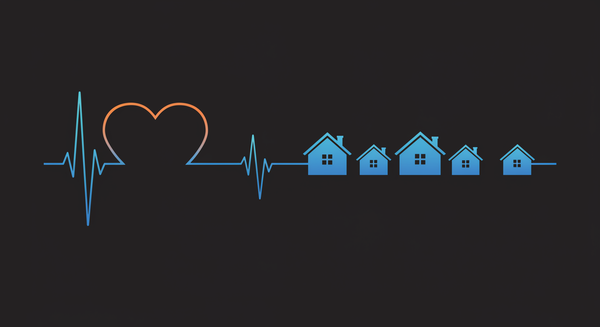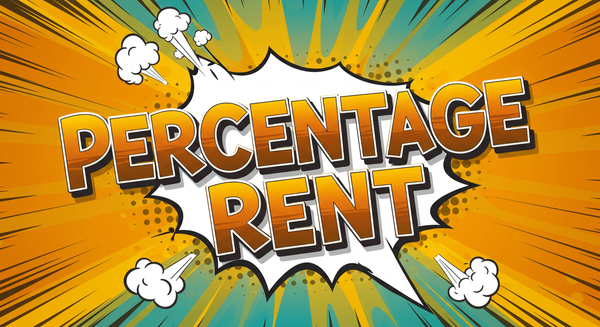Common Area Maintenance (CAM): The Complete Guide for Property Managers and Landlords
You'll learn: What CAM really means in today's market, how it impacts your bottom line, the legal frameworks that protect you, and proven strategies that transform cost allocation from a source of tension into a competitive advantage.

Here's a stat that'll make even experienced property managers do a double take: in some high-end commercial buildings, common area maintenance (CAM) charges can eat up 40% of a tenant's total occupancy cost.
Yes. You read that right.
Nearly half of what tenants pay goes not to their own four walls—but to the sparkling lobby, snow-free sidewalks, and meticulously trimmed hedges designed to impress.
Let's imagine a scenario where two seasoned property managers, early morning coffee in hand, are talking shop. One leans in and says, "You know what's still a mess? CAM allocations." That convo never dies. Because whether you're overseeing a buzzing retail center or a Class A office campus, fair CAM distribution is more than just simple math.
You don't build a thriving tenant experience just by throwing numbers in a spreadsheet. You build it by making costs feel justified, shared spaces feel intentional, and tenants feel like they're getting value for what they're paying.
Imagine walking your site at sunrise. The lobbies? Freshly polished. The landscaping? Spot on. The parking lot? Cleared of snow like magic. But none of that happens by accident. Behind every cleaned tile and shoveled driveway is a complex web of CAM fees that you—not the tenants—are responsible for untangling and explaining.
Here's what we're unpacking:
- What CAM actually means (like, really means)
- Why it impacts your property's financial story
- The legal must-knows (yes, there are rules)
- And most importantly—how to stop CAM from being a friction point and start making it a strategic advantage
What Is Common Area Maintenance (CAM)?
CAM is the financial engine running beneath the polished floors and behind the security desk. It's not flashy. It's not fun. But it's the glue holding your entire commercial property ecosystem together.
And no—it's not optional.
Common area maintenance is the budget line powering everything outside the tenant's private space. The lobby, restrooms, landscaping, snow removal, lighting, HVAC, trash collection, elevators, and a dozen other "invisible" services tenants notice instantly when they're missing.
According to the Institute of Real Estate Management (IREM), CAM encompasses "those maintenance items common to all the residents and/or tenants of a property." This professional definition helps establish the scope and responsibility framework that property managers must navigate.
You can think of CAM as the connective tissue between units. It turns isolated tenant suites into a unified, professional environment that feels managed. And that feeling? It's part of what tenants pay for—even if they don't always realize it.
Take a stroll through a well-run shopping center. Covered walkways. Spotless restrooms. Trash bins that are somehow always empty. That's CAM, pulling the strings. When it's done right, tenants stay longer, complain less, and renew more often.
Now here's where it gets technical: CAM covers a wide (and surprisingly deep) range of expenses. You've got:
- Day-to-day operations (cleaning, lighting, water)
- Seasonal requirements (snow removal, pest control)
- Safety and security (alarms, cameras, patrols)
- Infrastructure maintenance (HVAC, elevators, roofing)
- And yes—even the mulch in the flower beds
If it's part of the shared space and required to keep the property looking like it has its act together? It's CAM.
In the past, tracking all these costs was a messy cocktail of spreadsheets, estimates, and tenant disputes waiting to happen. But today? You've got commercial real estate software that can allocate every penny with precision. You can track expenses down to the square foot. You can generate clean reports. And—this is key—you can prove to tenants where their money's going.
Properties that invest in this level of tracking? They don't just save time—they get higher satisfaction scores, faster lease renewals, and fewer angry emails about "mystery maintenance fees."
So here's the point: base rent covers the tenant's unit. CAM bridges the gap between that unit and the fully functioning property around it. And the smartest landlords? They make CAM crystal clear, because when it's transparent, it becomes a trust builder—not a cost complaint.
Why CAM Matters in Property Management
Let's talk bottom line.
Well-managed CAM charges ripple through everything that matters: tenant retention, NOI, lease renewals, and your property's competitive edge. And while CAM may seem like a boring operational line item, it's often one of the biggest swing factors in your property's performance.
Here's the money stat: CAM typically ranges from $3.00 to $17.00 per square foot annually. That's not pocket change. It's a material portion of your tenants' spend—and one that can make or break your renewal rate.
Miss the mark on allocation? Boom—back charges, angry tenants, or worse, legal threats. One tenant starts asking questions. Then another. Suddenly, you're neck-deep in documentation requests, disputes over fairness, and awkward conversations that suck energy from your team.
And trust me, no one wins CAM arguments. Even if you're right, you've lost time, goodwill, and possibly a renewal.
On the flip side: get CAM transparency right, and you've got a legitimate moat. Properties with clear, fair, well-documented CAM charges consistently outperform in tenant satisfaction surveys. Not just "doing okay"—outperforming. That leads to:
- Longer lease terms
- Higher tenant lifetime value
- Reduced churn
- Better reviews
- Fewer fire drills
See the pattern?
Now let's zoom out: this isn't just about tenant mood swings. It's also about preserving the long-term value of your asset. Preventative maintenance—paid for through smart CAM allocation—is what protects your asset from surprise repairs that blow up your CapEx budget.
Proactive landscaping? Snow removal before it turns to ice? Regular HVAC service? All these things prevent the phone call that starts with, "You're not going to like this…"
Bottom line: investing in comprehensive common area maintenance isn't a nice-to-have. It's a strategic hedge against future cost explosions.
Now let's get into lease admin: the more vague your CAM language, the more complex and risky your lease becomes. Why? Because unclear documentation = exposed liability. If you can't justify every line, you're a sitting duck for tenant audits.
But if you've got modern lease management software doing the heavy lifting?
- Expense reports: clean
- Audit trail: bulletproof
- Tenant comms: proactive, not reactive
- Trust level: way higher
Properties using CAM automation see higher tenant satisfaction scores and fewer billing disputes—because everyone can see exactly what's happening and why.
And one more thing: understanding CAM is crucial for valuation. Cap rates and CAM are tightly linked. Efficient CAM management improves your NOI, which boosts your valuation. So yeah—CAM isn't just an operations thing. It's a finance thing too.
Real-World Applications of CAM
Let's bring this out of theory and into reality. Because nothing makes CAM make sense like seeing what happens when it's done right—or wrong.
These three examples show how strategic CAM management can turn headaches into high-fives—and how failing to adapt just lights fires.
Example 1: Shopping Center Success Story
Challenge: 150,000 sq. ft. retail complex. Think: food courts, anchor stores, seasonal foot traffic, the works. But tenants were not happy. CAM charges felt random, and the maintenance quality? Inconsistent at best.
Translation: complaints piling up, lease renewals dropping, and "WTF is this line item?" emails coming in hot.
Solution: The property manager stepped up. They implemented structured CAM provisions using modern lease administration software to track every expense—down to the penny. From landscaping to parking lot resurfacing, tenants got monthly reports showing their pro rata share.
Outcome: Tenant satisfaction jumped 40% in six months. Lease renewals spiked from 65% to 85%. Tenants saw where their dollars went—and stopped questioning every invoice.
Takeaway: CAM doesn't have to be a black box. When you show tenants what's behind the curtain—and it makes sense—you turn a potential conflict into a competitive advantage. Especially when tenants feel like they're getting value, not just bills.
Example 2: Office Complex Optimization
Challenge: Multi-building office park. Operating under gross leases. But expenses were rising—fast. Energy, security, general upkeep. The property owner was bleeding margin, with no clear way to recover costs.
Solution: They transitioned to net leases with detailed CAM clauses. This opened the door to smart upgrades—like energy-efficient systems and enhanced security—paid for transparently via CAM.
Outcome: Maintenance costs dropped 25%. Tenant satisfaction climbed. The upgrades created a premium feel, justifying higher rents across the board.
Takeaway: When CAM is structured right, you can fund improvements, not just upkeep. Tenants get a better experience, and you get a healthier P&L. Everyone wins.
Example 3: Mixed-Use Development Excellence
Challenge: Retail, office, and restaurants—all in one place. Different usage patterns, different hours, wildly different impact on shared resources. But CAM was being allocated like every tenant used the space equally.
Spoiler: they didn't.
Solution: Enter smart tech. The team brought in commercial real estate software that allowed them to create custom CAM formulas. Landscaping and parking were allocated based on actual traffic patterns, not just square footage.
When dealing with cost-benefit analysis for shared facilities, this approach made all the difference.
Outcome: Each tenant type got a bill that felt fair. No one argued because the math made sense. Result? 95% lease term completion rate across the property. (That's ridiculously good.)
Takeaway: One-size-fits-all doesn't work when your tenant mix looks like a food court married a WeWork. Custom allocation logic + transparent explanation = satisfied tenants who stay.
Legal + Compliance Considerations
Let's get something straight: CAM isn't a free-for-all.
There are rules. Regulations. Disclosure laws. Audit rights. And yes—courts that love to side with tenants when things get murky. So if your CAM language is vague or you're slipping capital improvements into operating costs, you're not just risking tenant blowback—you're leaving yourself wide open to legal drama.
Let's break this down.
Federal and State Regulatory Framework
Navigating CAM law means juggling two layers:
- Federal guidance (especially on government-leased properties)
- State-by-state statutes that range from crystal clear to "good luck figuring it out"
At the federal level, General Services Administration (GSA) leases offer pretty tight CAM standards. And while you might not lease to the government, their frameworks often set the tone for what's considered "reasonable."
But things get spicy at the state level:
- Texas Property Code Chapter 92 outlines landlord CAM responsibilities in detail.
- California? You're looking at very strict disclosure requirements—before lease execution.
- Florida? More flexible, but you still better have your allocation math tight.
- New York? Special rules kick in depending on tenant category.
Bottom line: every state has its quirks. And if you're managing a multi-state portfolio? You need legal review baked into your lease process—every time.
The Tax Angle
Triple net leases (NNN) often bundle CAM with taxes and insurance. Sounds simple—but it gets tricky fast. Because property taxes fluctuate. So if you're not documenting everything with precision, you're setting yourself up for disputes… or audits.
Understanding tax responsibilities in triple net leases becomes crucial when CAM charges intersect with property tax allocations.
And local tax boards don't mess around. If your CAM math overlaps with your tax assessments in the wrong way, it can backfire. Fast.
Essential Legal Safeguards
Let's get into the tactical must-haves. If you want your CAM structure to hold up under legal scrutiny (or just survive a tenant audit), these five things aren't optional:
✅ Document everything Invoices. Allocation formulas. Vendor contracts. If it goes into the CAM calculation, it should be paper-trailed and timestamped. Courts love transparency. So do tenants.
✅ Disclose early and often Before the lease is signed, walk tenants through CAM provisions. That means sample calculations, clear cost categories, and realistic ranges. The earlier you show your work, the fewer "gotcha" moments later.
✅ Use fair, defendable allocation methods Pro rata share based on Gross Leasable Area (GLA) is the industry standard for a reason. Don't get cute or try to sneak through custom ratios that unfairly favor one tenant over others. If you can't explain the math out loud without blushing, don't do it.
✅ Include audit rights + perform regular reviews Many tenants already have the right to audit you. Make sure you've got a clean paper trail to back up every cost. And even if they don't audit? You should. Annual reviews keep your numbers tight and prevent future disputes.
✅ Spell out exclusions clearly Want to avoid 90% of CAM disputes? Be explicit about what's not included. Professional property management standards from BOMA emphasize that your exclusions list should always feature:
- Capital improvements
- Debt service
- Landlord profits
- Anything not tied directly to shared space operation
If you blur those lines, you'll end up explaining them—to tenants, attorneys, or a judge.
One final thing: When CAM provisions are ambiguous or seem padded? Courts usually side with the tenant. Every time. So if you want to stay compliant and keep tenant relationships intact, the formula is simple:
Clarity + consistency = legal protection.
Best Practices for CAM Management
Ready to stop CAM from being a recurring fire drill? These five best practices aren't just "nice-to-haves." They're your operational edge—the difference between getting dragged into CAM disputes and becoming the property manager tenants actually trust.
Let's break it down.
1. Implement Transparent Cost Allocation Systems
What it is: Modern property management software that tracks, categorizes, and allocates every CAM dollar with total transparency.
Why it matters: Today's tenants want receipts. Literally. They expect detailed breakdowns, and if you can't give it to them? You've already lost credibility. Transparency = fewer arguments, faster approvals, and better lease renewals.
How to do it: Invest in a CAM-aware lease administration platform that:
- Tracks costs by vendor and service type
- Allocates expenses using your lease-defined formulas
- Auto-generates monthly or quarterly breakdowns per tenant
- Keeps audit-ready logs with zero manual work
Tools to use: Look for platforms with built-in CAM modules—they should handle everything from snow removal invoices to landscaping contracts and spit out tenant-facing reports in minutes.
2. Establish Comprehensive Preventative Maintenance Programs
What it is: Maintenance that doesn't wait for stuff to break. Think: scheduled landscaping, HVAC inspections, lighting replacements—before tenants even notice something's off.
Why it matters: Preventative work funded through CAM reduces long-term costs and avoids emergency repairs that blow up your budget. Plus, it keeps your property looking "premium"—which justifies premium rent.
How to do it:
- Build a maintenance calendar that covers all shared spaces
- Include regular inspections + performance checks
- Prioritize services with the highest visibility or operational risk
- Lock in reliable vendors with long-term contracts
Tools to use: Use maintenance management software that syncs with your CAM allocation system. That way, scheduled work is automatically tracked and charged to the right tenants without manual entry.
3. Master the Art of Tenant Communication
What it is: Not just sending a statement. Actually showing tenants how CAM charges improve their environment and why they matter.
Why it matters: When tenants understand where their money goes, they're way more likely to pay it—and less likely to file disputes. Well-informed tenants are loyal tenants.
How to do it:
- Send quarterly CAM update reports with photos or "before/after" examples
- Offer to walk tenants through charges during renewal
- Host annual tenant Q&As (especially for larger properties)
- Use CAM as a chance to highlight your property's quality
Tools to use: Implement tenant portals that allow 24/7 access to maintenance schedules, real-time expense logs, and upcoming CAM projects. No more "I didn't know about that" excuses.
4. Optimize Controllable vs. Uncontrollable Expense Categories
What it is: Not all expenses are equal. Controllable = stuff you can influence (landscaping, security contracts). Uncontrollable = taxes, insurance, etc. Segmenting them helps you actually manage what matters.
Why it matters: CAM costs spike when no one's steering the ship. By managing controllables, you stabilize charges even when external factors fluctuate. And you build credibility by showing tenants you're actively containing costs.
How to do it:
- Review all vendor contracts annually
- Bundle services across properties for volume discounts
- Audit energy usage and implement savings programs
- Clearly label uncontrollables in every tenant report
Tools to use: Use expense management platforms that auto-tag and benchmark costs. Bonus points if they offer comparisons to similar properties in your market.
5. Structure Lease Agreements for CAM Success
What it is: CAM starts in the lease. If the language is vague, you've already lost. If it's clear, you're protected.
Why it matters: Well-structured leases prevent disputes before they start. Bad lease language leads to confusion, frustration, and... court.
How to do it:
- Define CAM clearly, line by line
- Detail the allocation method (e.g., pro rata based on GLA)
- Cap annual increases if possible (but not so tight you can't adjust)
- Include clear dispute resolution language
- Standardize clauses across tenants and property types
Tools to use: Run all CAM-related lease language through commercial real estate legal review platforms. Or at minimum, have a go-to attorney who knows the local laws and what's typical in your asset class.
Pro tip: If you want CAM to drive property value (and not just be a billing exercise), tie it to performance.
- Do the numbers support your valuation goals?
- Are you recovering enough costs to protect NOI?
- Are tenants still renewing because they see the value?
If not? You've got a CAM problem disguised as a lease problem.
Related Concepts & Terminology
If you're going to talk CAM like a pro (or defend it when a tenant challenges you), these are the terms you need locked and loaded. Think of this as your cheat sheet for sounding smart—and staying out of trouble.
Additional Rent The catch-all bucket that includes CAM, taxes, and insurance. This is everything tenants pay on top of their base rent to help operate shared spaces like a normal, functioning business.
Gross Lease The "all-in" pricing model. CAM is baked into the rent, which keeps billing simple but blurs the actual cost breakdown. Easy for tenants, annoying for property managers who want flexibility.
Net Lease The grown-up version. Tenants pay base rent plus their share of operating expenses like CAM. It's transparent, flexible, and ideal for scaling your property like a well-oiled machine.
Gross Leasable Area (GLA) The total rentable square footage across your property. This is your denominator when calculating CAM allocations. Get this wrong, and your entire CAM math falls apart.
Pro Rata Share The CAM split formula. If a tenant leases 5,000 sq. ft. in a 100,000 sq. ft. building, their pro rata share is 5%. That 5% applies to all shared costs. Simple math, big implications.
Why this matters: Clear definitions = cleaner conversations with tenants, fewer disputes, and better internal reporting. These concepts are the foundation of your CAM strategy—whether you're negotiating leases, explaining charges, or justifying NOI to investors.
If you're managing mixed-use, multifamily, or anything beyond cookie-cutter office? These terms become your daily language. Get fluent.
For CAM challenges in multifamily properties, understanding these fundamentals becomes even more critical due to the unique nature of residential vs. commercial tenant expectations.
Common Questions
Let's face it—tenants have questions. Lots of them. And if your team can't answer these quickly and clearly, it undermines your credibility. Here's your go-to answer bank for the ones that come up the most.
What's the difference between CAM charges and base rent? Base rent covers your tenant's private space—walls, floor, ceiling, done.
CAM charges cover everything else they use but don't control: the lobby, hallways, elevators, landscaping, lighting, snow removal, security, janitorial... the list goes on.
Think of base rent as paying for your apartment. CAM is the HOA fee that makes sure the front door works, the lawn's trimmed, and the hall doesn't smell like regret.
How are CAM fees calculated for commercial properties? It's all about square footage.
Let's say your tenant leases 2,000 sq. ft. in a 50,000 sq. ft. building. That's 4% of the total space. So? They're responsible for 4% of total shared operating costs. If CAM costs total $100K this year, that tenant owes $4K.
And yes—it should be spelled out in the lease. If it's not? Time to fix that.
Understanding screening property financial performance helps ensure your CAM calculations align with overall property investment metrics.
Can CAM charges increase during my lease term? Usually, yes.
Most leases allow for annual reconciliations based on actual costs. If expenses go up (hello, rising utility rates), CAM can too. Some tenants negotiate caps or not-to-exceed clauses, but if your lease allows adjustments—and it should—expect movement year to year.
What expenses should NOT be included in CAM charges? Let's make this simple. These are never valid CAM items:
- Capital improvements (like replacing the roof)
- Mortgage payments or debt service
- Landlord profit or markup
- Leasing commissions or marketing costs
If it doesn't directly maintain or operate shared space, it doesn't belong in CAM. End of story.
How can I verify that my CAM charges are fair and accurate? Ask for the breakdown—and then check the math.
Every lease should come with annual CAM statements that show:
- Total property costs
- Your pro rata share
- Supporting invoices (if requested)
Many leases also include audit rights if charges exceed a certain threshold. If something feels off? Ask for docs. If the landlord can't produce them? That's a red flag.
According to Wall Street Prep's financial analysis guidelines, tenants should expect detailed cost breakdowns that demonstrate how their fees support actual common area operations rather than profit generation.
Bonus insight: CAM charges also influence property valuation. Appraisers look at how well your maintenance programs run and how efficiently CAM is recovered when assessing NOI. Appraisal considerations for operating costs play a significant role in determining overall property value. So yes—CAM isn't just a tenant concern. It's an asset strategy.
Visualization Concepts
Some people need data. Others need diagrams. These visuals help you explain CAM to execs, tenants, or new hires who glaze over at spreadsheets.
Here are the three visuals every property manager should have in their back pocket:
1. CAM Ecosystem Overview
Type: Flowchart What it shows:
- How base rent, CAM charges, and additional rent stack up to form total occupancy cost
- Visual links between private tenant space and shared property areas
- The "invisible services" that keep the whole machine running
Why it works: It reframes CAM from "extra fees" to shared infrastructure investment. Especially useful during lease negotiations and annual reconciliations.
2. Cost Distribution Analysis
Type: Interactive pie chart (or static if you're old school) Data: Breakdown of typical CAM expenses:
- Landscaping
- Snow removal
- Utilities
- Security
- Janitorial
- Repairs
- Insurance (if applicable)
Why it works: Shows exactly where the money goes—and makes the "what am I paying for?" conversation disappear. Transparency builds trust. This is your visual proof.
CAM Cost Distribution Analysis
Where Every Dollar Goes - Complete Transparency
$12.50
per sq ft annually
Expense Breakdown
Based on 10,000 sq ft property
3. Decision-Making Workflow
Type: Decision tree or checklist flow What it includes:
- How to set CAM provisions during lease drafting
- Annual reconciliation steps
- How to handle tenant audits or disputes
- Key legal checkpoints
Why it works: Helps your team move from reactive to proactive. When CAM is mapped out like a process—not a panic—it saves time, money, and headaches.
CAM Decision-Making Workflow
From Reactive to Proactive: Your Complete Guide to CAM Management
Legal Checkpoint
Ensure CAM provisions comply with local regulations and include:
- Clear definition of "Operating Expenses"
- Audit rights for tenants
- Cap on administrative fees (typically 10-15%)
- Dispute resolution procedures
Documentation Requirements
Maintain complete records for audit defense:
- All original invoices and receipts
- Detailed general ledger reports
- Occupancy reports for the reconciliation period
- Written documentation of allocation methodology
Common Audit Challenges
Be prepared to defend:
- Management fee calculations and caps
- Capital improvement amortization methods
- Allocation of expenses between retail and office
- Exclusion of non-recoverable expenses
- Documentation for extraordinary expenses
When to Involve Legal Counsel
Escalate to legal team when:
- Tenant disputes exceed $25,000
- Class action audit threatened
- Regulatory compliance questions arise
- Lease interpretation disputes occur
- Litigation appears likely
🧠 Pro tip: Use these visuals in tenant onboarding packets, investor presentations, and internal SOPs. Not everyone reads lease clauses. But everyone gets a pie chart.
Conclusion & Resources
Let's be real: most people treat CAM like a necessary evil. A complicated, low-visibility cost center they'd rather not think about.
But that's a mistake.
When managed strategically, CAM is your leverage—a tool to build trust, boost tenant satisfaction, and increase asset value. The property managers who understand this? They win. Everyone else ends up chasing disputes, justifying vague charges, and watching renewals slip away.
Here's the bottom line:
🔍 Transparency builds trust When tenants understand where their money's going, they stop fighting the fees and start appreciating the shared experience. The most successful landlords? They turn CAM into a feature, not a fight.
🧠 Technology enables precision Stop manually allocating snow removal charges with a calculator from 1998. CAM-specific lease admin software breaks down costs by tenant, property, service, and season. It's accurate, scalable, and audit-proof.
🛠 Prevention saves money Preventative maintenance funded through CAM isn't just good property hygiene—it's ROI. Fixing the roof before it leaks is 10x cheaper than repairing tenant trust after it does.
🧾 Legal protection requires clarity Vague lease language and undocumented charges? That's a lawsuit waiting to happen. Detailed CAM clauses and clean cost records = peace of mind and fewer legal bills.
🚀 The CAM advantage Professional CAM management doesn't just recover costs—it drives performance:
- Higher tenant satisfaction
- Longer average lease terms
- More predictable NOI
- Stronger market positioning
- Premium rents you can actually defend
Think of it as a flywheel: great maintenance makes the property better → better experience increases tenant value → tenant value justifies CAM spend → everyone wins.
📚 Ready to turn CAM from cost center to competitive edge?
Here's what to do next:
- 📥 Download our CAM calculation templates – Make allocations easy and audit-ready
- 🧰 Explore our full property management resource library – From lease language samples to reconciliation workflows
- 🎯 Schedule a 1:1 consultation – We'll walk you through how to optimize your CAM strategy and tie it to portfolio performance
CAM isn't just math.
It's a reflection of how well you manage shared responsibility.
When you get it right?
You don't just maintain the property—you lead it.





